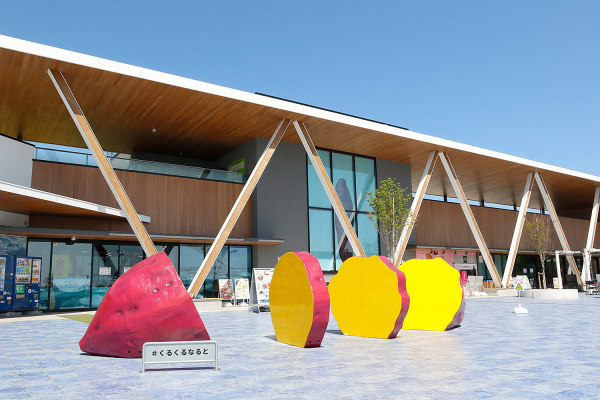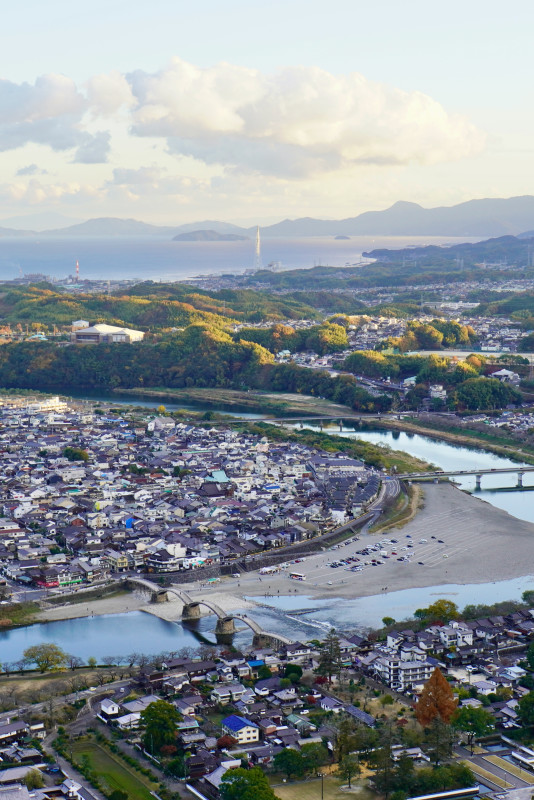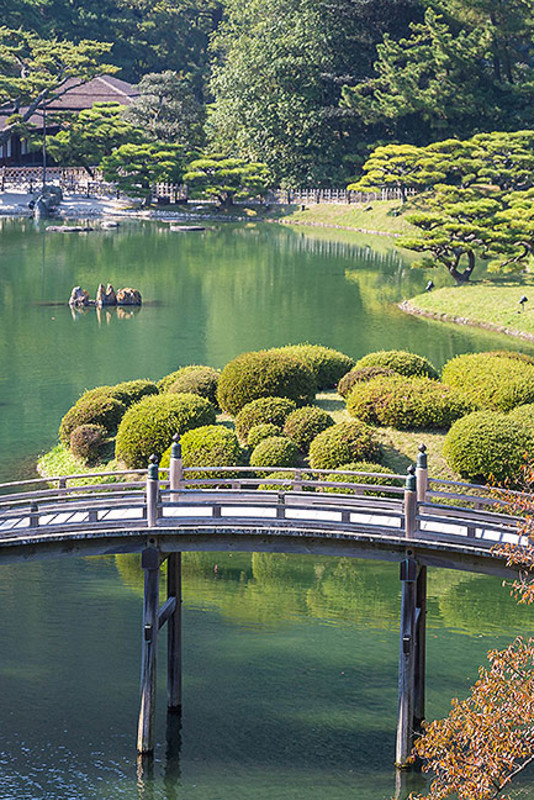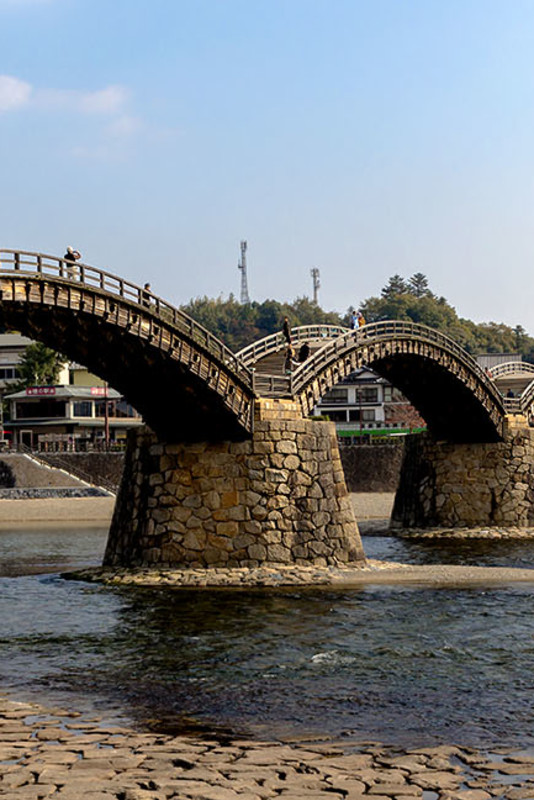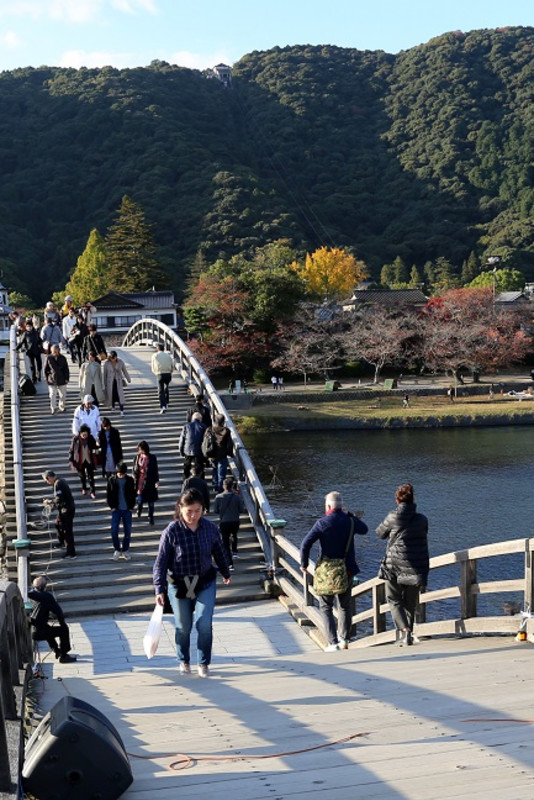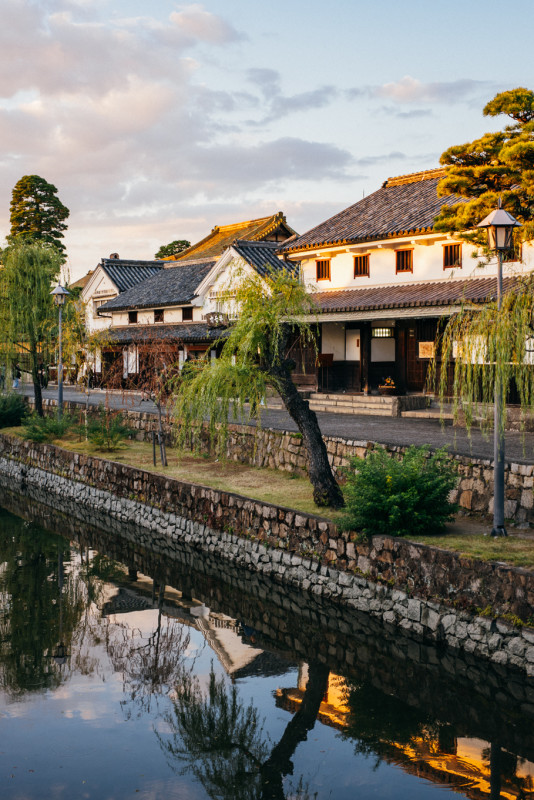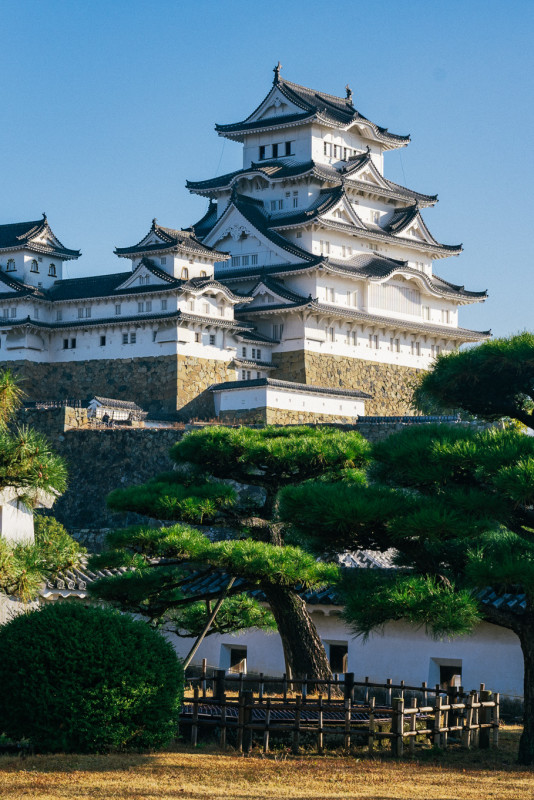Itineraries
Take a Deep Dive into Traditional Arts and Crafts in the Castle Towns of Setouchi

This four-day itinerary, which includes visits to the contrasting castles of Himeji and Okayama and the merchant district of Kurashiki, also invites you to delve into the world of samurai sword-making and ancient ceramics. After a relaxing stay at Kinosaki Onsen, this trip finishes in the hidden gem of Tamba Sasayama.
- Day 1
- Okayama, Bizen and Kurashiki
Okayama Castle and Korakuen Garden
The majestic black facade of Okayama Castle, from which it earned its moniker, 'Crow Castle', provides a striking contrast to the pristine white walls of Himeji Castle. Positioned gracefully alongside the flowing Asahi River, Okayama Castle invites you to relax and absorb the breath-taking views of the castle itself and adjacent Korakuen Garden. Explore distinctive architectural features of Japanese castle design, view the discover workshops dedicated to the region’s famous Bizen-yaki pottery before your visit to an authentic kiln later in the day and don traditional princess or feudal lord attire for a memorable photoshoot.
The Hayashibara Museum of Art, in the castle grounds, has a prodigious collection of swords, armor, Noh costumes and masks, furniture, paintings, calligraphy, lacquer work and pottery. The building itself is also impressive. Designed by Kunio Maekawa, one of Japan’s most respected architects, seamlessly merges tradition with modern architectural brilliance.
Korakuen Garden, ranked among the top three in the country, is a harmonious fusion of meticulously manicured landscapes, tranquil ponds, and enchanting traditional architecture. Immerse yourself in the timeless beauty of sculptured landscapes, traditional tea houses, and vibrant koi ponds—a symbol of wealth and power in Japanese culture.
Within the garden you can experience several Japanese traditions. Any time of the year you can try a Japanese tea ceremony in one of the tea houses within the garden. At certain times of the year, some of the formal buildings host tea ceremonies where masters host and teach you the art of tea.
To fully immerse yourself in this rich cultural enclave, we recommend obtaining the Okayama Castle and Korakuen Garden Pass.
URL: https://okayama-castle.jp/home-en/
Travel: Okayama to Bizen Osafune Sword Museum
・Take a local train from Okayama Station to Osafune Station (Approx 30 minutes)
・Take a taxi to the Bizen Osafune Sword Museum (Approx 8 minutes)
Bizen Osafune Sword Museum
Of the 111 Japanese swords designated as National Treasures, 47 of them were made in Bizen. Easily accessible by river and blessed with a plentiful supply of high-quality iron sand and the abundant forests needed to make the large amounts of charcoal required for smelting, the area of Osafune in Bizen province developed into a renowned production site of quality swords in the medieval period. A visit to the Bizen Osafune Sword Museum is a must if you have a strong interest in the tradition and culture of sword making.
Located in Japan’s sword Mecca, as well as exceptional displays, artisans also work onsite, each contributing to one of the intricate processes involved in the crafting of a finished sword. Most spectacular of all, it is possible to see the hammering of the tamahagane steel from which these works of art are wrought. Held on the second Sunday of each month, make sure to book your spot and see this live traditional smithing demonstration up close.
The museum also holds knife-making workshops. Making your own “kogatana” (small knife) involves multiple visits spread over several weeks, but one-day paper knife making workshops can be scheduled through discussion with the museum. All workshops require reservations at least two weeks in advance. Check the museum website for the latest details.
URL: https://www.city.setouchi.lg.jp/site/token/
Travel: Bizen Osafune Sword Museum to Imbe
・Take a taxi from the Bizen Osafune Sword Museum to Osafune Station (Approx 8 minutes)
・Take a local train from Osafune Station to Imbe Station (Approx 10 minutes)
Bizen-yaki Pottery Street: The oldest pottery kiln in Japan
Thought to be the oldest of Japan’s “six ancient kilns,” the history of Bizenyaki pottery goes back over 1000 years. Bizen ware is known for its natural and modest beauty of its unglazed finish which often expresses the vagaries of firing process. Although the The Bizen Pottery Museum is closed for renovations until the spring of 2025, Imbe is home to more than 100 potteries and galleries, in a small town over which red brick chimneys of the kilns look down on roofs adorned with Bizen-yaki tiles.
Mugenan Kiln offers pottery workshops where you can learn the basics of Bizen pottery making from master artisanss. It is often said that Bizenyaki enhances the flavors of food and drinks on and in which it is served. Test the theory for yourself at the kiln’s affiliated cafe, one of many cafes and eateries in the region that uses Bizen ware.
Every October, thousands of visitors come to Imbe for the Bizen Pottery Festival, a vibrant two-day celebration of all things Bizenyaki. It’s a lively event that offers a unique opportunity to witness the fusion of tradition and innovation that propels Bizen pottery into the future.
Travel: Imbe to Kurashiki
・Take a local train from Imbe Station to Kurashiki Station (Approx 1 hour - 1 hour 15 minutes)
Take an evening stroll in the Kurashiki Bikan Historical District
The charming Bikan Historical Preservation District of Kurashiki's merchant quarter invites you to explore its narrow streets, lined with the beautifully preserved white-walled traditional warehouses (kura) that gave the town its name. As night descends and the streets are illuminated, and Kurashiki takes on a serene ambiance, offering a different, yet equally captivating, experience to exploring the daylight.
Accommodation: Ryokan Kurashiki
Ryokan Kurashiki, overlooking the canal that runs through the heart of Kurashiki’s historical district, is in one of the most picturesque locations in the district and is considered the best traditional Japanese inn experience in the area. Housed in a former sugar warehouse, all Ryokan Kurashiki’s eight rooms have a traditional architectural aesthetic with stylish accents and modern comforts such as low profile western beds. The Okuzashiki suite, tucked away within the depths of the ryokan, feels like staying in your own private villa. Exquisite seasonal kaiseki dinners, featuring the abundant produce of the Setouchi region, and beautifully presented breakfasts are a highlight. Use of a private onsen is also available by reservation.
URL: https://www.ryokan-kurashiki.jp/en/top.php
- Day 2
- Kurashiki, Himeji and Kinosaki Onsen
Kurashiki Bikan Historical Preservation District
Kurashiki prospered as a political center and trade hub after coming under the direct control of the Tokugawa Shogunate in 1642. Kurashiki’s fortune continued during the late 19th century and early 20th century, this time led by the textile industry. As the town escaped relatively unscathed in WWII, the mix of traditional Japanese and Western-style warehouses and mansions built along the Kurashiki River still remain. In the Bikan Historical District, you can take a walk through history, from the time of the samurai to Japan’s emergence as an industrial powerhouse.
Kurashiki’s historical quarter is not only expertly preserved, but also quite lively. A wide variety of shops, cafes and eateries, from traditional to trendy, are based in the warehouses, and it is a pleasure to wander around the town. Traditional boat tours along the Kurashiki Canal that flows through the district, allow you to admire the town's charm from a different perspective. Several places rent kimono and yukata for visitors to fully embrace the historical vibe.
Museum and culture lovers are well catered for within this compact, walkable area. Prime among Kurashiki’s museums is the Ohara Museum of Art which has an impressive collection of internationally acclaimed masterpieces. The Kurashiki Museum of Folkcraft and Kurashiki Archaeological Museum are appropriately housed in 200-year-old rice granaries. Ivy Square, a red brick facility on the site of a former cotton mill, offers a variety of workshop activities, including Bizen-yaki pottery, which is one of Japan's six ancient pottery styles.
There are many places to eat around Kurashiki’s historical district, but, if you are looking for a refreshingly sweet treat, one in particular deserves a special mention. Kurashiki Momoko is very popular for its gorgeous and tasty parfaits, desserts and cakes featuring seasonal fruits, including many that are locally grown in Okayama Prefecture. Okayama’s mild climate and technical skill of its farmers have earned it the nickname of the “Kingdom of Fruit” and Kursashiki Momoko is a great place to sample some. There are four outlets to choose from, but the original Sohonten has an impressive collection of French Art Nouveau glassware by Émile Gallé on display.
Travel: Kurashiki to Himeji
・Take a local train from Kurashiki Station to Shin-Kurashiki Station (Approx 10 minutes)
・Take the Shinkansen from Shin-Kurashiki Station to Himeji Station (Approx 45 minutes)
Experience the enchanting beauty and rich history of Himeji Castle
UNESCO World Heritage Site Himeji Castle stands as a testament to Japanese architectural brilliance. The sprawling castle grounds boast an impressive collection of over eighty meticulously designed buildings, the centerpiece of which is the Tenshu-gun, a complex comprising the donjon, keeps, and connecting structures, which showcase an intricate and highly advanced system of defense that dates to feudal times. The masterful construction and exquisite woodwork are awe inspiring, as are the elegant white plastered walls, from which its nickname, ‘White Heron Castle,’ comes.
In spring, over 1000 cherry trees come into bloom, creating breath-taking scenes viewable from both outside and inside the grounds. In the autumn the same trees turn fiery red around a week or so earlier than maple trees in the regions begin to change color.
Explore Japan’s rich garden heritage at Kokoen Garden
Immerse yourself in the refined elegance of the Edo era (1603-1868) as you wander through nine distinct gardens, each thoughtfully crafted to evoke a different facet of this bygone era, that make up Kokoen Garden. Unveiled in 1992, this splendid garden sits on the historic grounds of a former feudal lord's residence and has served as a backdrop for period TV dramas and movies. Take tea in the serene ambience of Soju-an tea house or treat yourself to a delectable lunch at renowned Kassui-ken where both the food and views provide a feast for the senses.
Nearby,
Harima-no-Kuni Sosha Shrine has a history spanning over 1,400 years. In the year 1181, a total of 174 deities from various shrines in Harima Province were enshrined together and the shrine was a place of worship for generations of powerful samurai and is known as the protector shrine of Himeji Castle.
Travel: Himeji to Kinosaki Onsen
・Take the local Hamakaze Limited Express (2 departures a day) train from Himeji station to Kinosaki Onsen Station (Approx 1 hour 45 minutes)
Kinosaki Onsen
Step back in time and wander along the riverside under weeping willows in this onsen resort that has been a destination for those seeking its reviving waters for 1300 years. There is no better place in the region to go local, and enjoy hot spring hopping in your yukata cotton kimono at seven tattoo-friendly onsens, than at this beautiful little town.
URL: https://visitkinosaki.com
Accommodation: Nishimuraya Honkan Ryokan
Experience the tranquility of Nishimuraya Honkan Ryokan, where an enchanting Japanese garden awaits you in the center courtyard. Delight in the view from your room as you gaze upon ancient pine trees, moss-covered stone statues, and serene ponds teeming with graceful koi fish. Immerse yourself in the lush greenery as accessible pathways beckon you to take a leisurely stroll. With a legacy spanning 150 years, Nishimuraya Honkan Ryokan proudly showcases a captivating collection of photographs, paintings, and artifacts that reflect the rich heritage of Nishimuraya. As a guest of Nishimuraya Honkan, you enjoy complimentary access to all the public onsens in Kinosaki, each offering its own distinctive charm and therapeutic benefits.
URL: https://nishimuraya.ne.jp/honkan/english/index.php
- Day 3
- Tamba Sasayama (Day 1)
Travel: Kinosaki Onsen to Tamba Sasayama
・Take the Konotori Limited Express from Kinosaki Onsen Station to Sasayama-guchi Station (Approx 2 hours)
Tamba Sasayama, Hyogo's Hidden Gem
Although relatively close to Osaka and Kyoto, Tanba Sasayama is a true hidden gem. This captivating region was long a bustling transportation hub for travelers heading to Kyoto, leaving behind a fascinating cultural legacy that permeates its townscape and vibrant festivals. With its castle town, a history of providing services to travelers, and surrounding farming villages, Tanba Sasayama is a place where authentic landscapes of traditional Japan can still be seen.
Near the ruins of Sasayama Castle, built early in the Edo era (1603-1868) as part of the Tokugawa Shogun’s strategy to safeguard his dominance after the great battle of Sekigahara, and in the Kawawara-machi merchant district, Edo-era townscapes can be enjoyed and there are several museums where you can learn more about the history of this fascinating region.
While carefully maintaining the charming historic townscape, an increasing number of renovated old houses have been transformed into new stores. This unique fusion allows you to relish local cuisine (the area is particularly famous for its chestnuts, black soy beans and wild boar game meat) and shopping experiences while immersing yourself in the captivating local history.
URL: https://tourism.sasayama.jp
Accommodation: NIPPONIA Sasayama Castle Town Hotel
Hotel NIPPONIA makes the accommodation one of the highlights of a stay in Tamba Sasayama. The company that aims to restore and preserve traditional buildings, has renovated no less than five such buildings in the castle town of Sasayama Castle. While adding modern comforts, the original atmosphere of each building has been kept intact, ensuring that visitors can fully experience its character and unique history.
Meals, served in the main ONAE building, are a fusion of Japanese and French cuisine, prepared by highly skilled chefs to the highest standards, utilizing the abundant produce of the area including black soybeans, chestnuts, matsutake mushrooms and, of course, premium Tajima Wagyu Beef.
Here, you can immerse yourself in the local way of life, experience the vibrant culture, and witness the ever-changing seasons, all while indulging in luxurious moments.
URL: https://stay.nipponia.or.jp
- Day 4
- Tamba Sasayama (Day 2)
Tambayaki Pottery, in history and everyday life
The roots of Tamba-yaki pottery date back over 800 years, and one of Japan’s “six ancient kilns” is located in Tamba Sasayama. There are about 60 pottery studios in the Tachikui district to the southwest, many of them along the 1.5 km long Yakimono Dori (Pottery Street). The Museum of Ceramic Art, Hyogo and the Tamba Traditional Crafts Park Tachikui no Sato are must stops for fans of ceramic arts and also offer pottery workshops. Bicycles can be rented from Tachikui no Sato which are great for getting to the oldest climbing kiln in Japan and checking out all the studios, shops and galleries in the area.
Close to Sasayama Castle are Ichiran Toubou. Run by a husband and wife team out of a cute, rustic gallery space, gallery space, working mainly on simple tableware.
Examples of distinctive cobalt blue celadon Ojiyama Pottery, made with traditional techniques, can be appreciated at the Ojiyama Pottery Center which revived this elegant style of pottery in 1988 after 120 years. Ojiyama Inari Shrine, reminiscent of Fushimi Inari Shrine in Kyoto and nicknamed Make-kirai Shrine ("Hate to Lose Shrine"), is a short walk from Ojiyama Pottery Center.
Travel: Tamba Sasayama to Osaka
・Take the train from Sasayama-guchi Station to Osaka Station (Approx 55 minutes - 1 hour 10 minutes)






































































